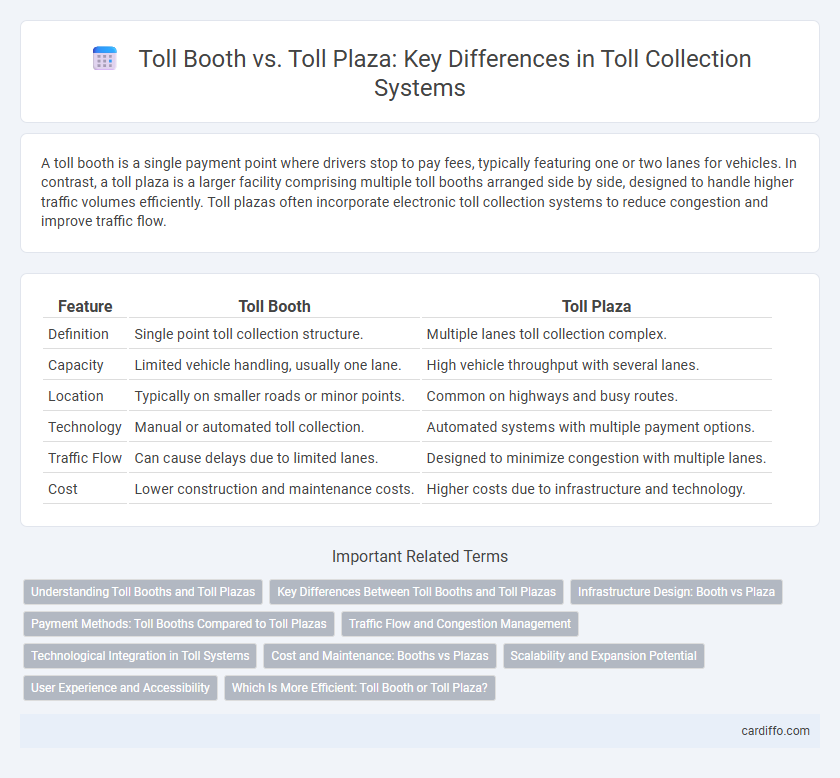A toll booth is a single payment point where drivers stop to pay fees, typically featuring one or two lanes for vehicles. In contrast, a toll plaza is a larger facility comprising multiple toll booths arranged side by side, designed to handle higher traffic volumes efficiently. Toll plazas often incorporate electronic toll collection systems to reduce congestion and improve traffic flow.
Table of Comparison
| Feature | Toll Booth | Toll Plaza |
|---|---|---|
| Definition | Single point toll collection structure. | Multiple lanes toll collection complex. |
| Capacity | Limited vehicle handling, usually one lane. | High vehicle throughput with several lanes. |
| Location | Typically on smaller roads or minor points. | Common on highways and busy routes. |
| Technology | Manual or automated toll collection. | Automated systems with multiple payment options. |
| Traffic Flow | Can cause delays due to limited lanes. | Designed to minimize congestion with multiple lanes. |
| Cost | Lower construction and maintenance costs. | Higher costs due to infrastructure and technology. |
Understanding Toll Booths and Toll Plazas
Toll booths are individual structures where drivers stop to pay toll fees manually or electronically, designed for efficient transaction processing and vehicle flow control. Toll plazas consist of multiple toll booths arranged side by side to handle high volumes of traffic, facilitating simultaneous toll collection across several lanes. Understanding the distinction between a toll booth and a toll plaza clarifies how road toll systems manage traffic congestion and revenue collection on highways.
Key Differences Between Toll Booths and Toll Plazas
Toll booths are individual structures where drivers stop to pay tolls manually or electronically, typically found on highways and bridges. Toll plazas consist of multiple toll booths grouped together in one area to manage high traffic volumes efficiently. The key difference lies in scale and functionality: toll plazas facilitate smoother traffic flow by offering several payment lanes, while toll booths operate as singular points of transaction.
Infrastructure Design: Booth vs Plaza
Toll booths are individual lanes equipped with a payment station where vehicles stop to pay tolls, designed for lower traffic volumes and simpler infrastructure requirements. Toll plazas, on the other hand, consist of multiple toll booths arranged in a wider configuration to accommodate high traffic flow and minimize congestion, often incorporating electronic toll collection systems and enhanced traffic management features. The structural design of toll plazas includes canopies, signage, and barriers for efficient vehicle sorting and safety, contrasting with the compact and straightforward layout of single toll booths.
Payment Methods: Toll Booths Compared to Toll Plazas
Toll booths typically accept cash, credit, or debit card payments directly at individual lanes, allowing for quick and straightforward transactions. Toll plazas, on the other hand, often feature multiple toll booths equipped with electronic toll collection systems such as RFID tags and transponders for automatic payment, reducing congestion. The integration of both manual and electronic payment methods in toll plazas accommodates a larger volume of vehicles and enhances traffic flow efficiency.
Traffic Flow and Congestion Management
Toll booths are individual payment points designed for vehicles to stop and pay tolls, often causing traffic congestion during peak hours due to limited processing capacity. Toll plazas consist of multiple toll booths arranged in a wide configuration, allowing simultaneous processing of numerous vehicles to enhance traffic flow and reduce bottlenecks. Advanced toll plazas implement electronic toll collection systems, further minimizing delays and improving congestion management effectively.
Technological Integration in Toll Systems
Toll booths typically feature individual payment stations equipped with automated barriers and electronic toll collection (ETC) systems like RFID or transponders, enabling seamless vehicle identification and toll processing. Toll plazas integrate multiple toll booths along with advanced technologies such as license plate recognition, video tolling, and centralized traffic management systems to optimize flow and reduce congestion. The technological integration in toll plazas enhances real-time data monitoring, dynamic pricing, and interoperability with smart transportation networks.
Cost and Maintenance: Booths vs Plazas
Toll booths typically incur lower initial construction costs compared to toll plazas due to their smaller size and simpler infrastructure. Maintenance expenses for toll booths often remain minimal, focused on electronic collection systems and basic structural upkeep, while toll plazas require more extensive maintenance for multiple lanes, signage, and traffic management systems. Operational costs for plazas tend to be higher because of increased staffing needs and more complex equipment to handle larger traffic volumes efficiently.
Scalability and Expansion Potential
A Toll Plaza consists of multiple Toll Booths arranged side by side, allowing for significant scalability by adding more booths to accommodate increasing traffic volumes. Toll Booths individually limit expansion potential due to physical space and operational constraints, whereas Toll Plazas are designed with modular expansion capabilities for efficient traffic management. Scalability in Toll Plazas supports future infrastructure growth and reduces congestion by enabling the addition of electronic toll collection lanes and advanced processing technologies.
User Experience and Accessibility
Toll booths often cause slower traffic flow and longer wait times, impacting user experience negatively, especially during peak hours. Toll plazas, designed with multiple lanes and electronic toll collection systems, enhance accessibility by reducing congestion and enabling seamless, quicker transactions. Improved infrastructure at toll plazas supports better mobility for all vehicle types, including those with special accessibility needs.
Which Is More Efficient: Toll Booth or Toll Plaza?
Toll booths handle individual vehicles at separate lanes, causing potential slowdowns during peak traffic, while toll plazas integrate multiple toll booths with automated systems for quicker processing. Toll plazas often include electronic toll collection technologies like RFID or license plate recognition, drastically reducing wait times and improving traffic flow. Efficiency favors toll plazas due to their higher vehicle throughput and reduced congestion compared to single toll booths.
Toll Booth vs Toll Plaza Infographic

 cardiffo.com
cardiffo.com